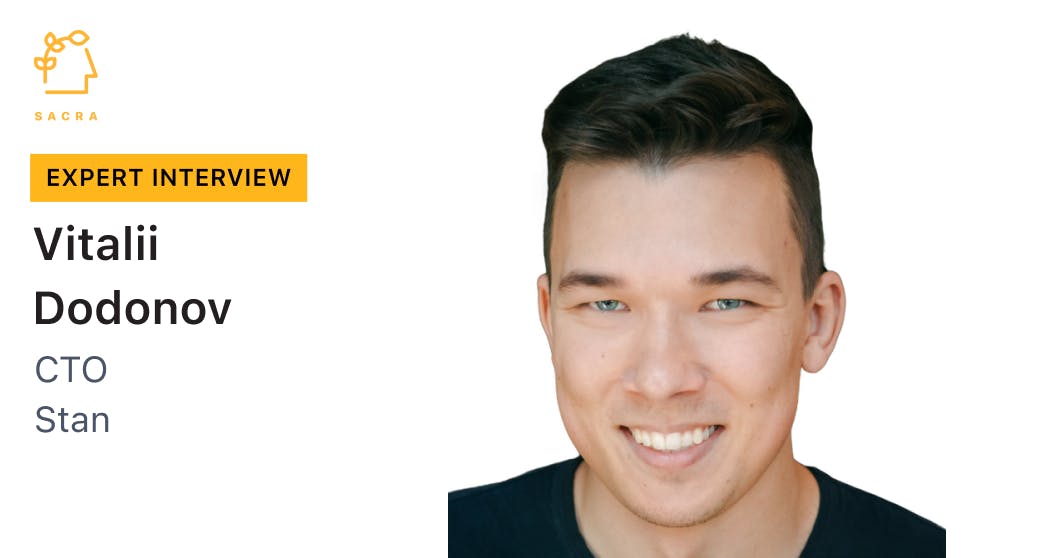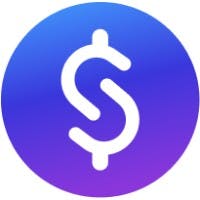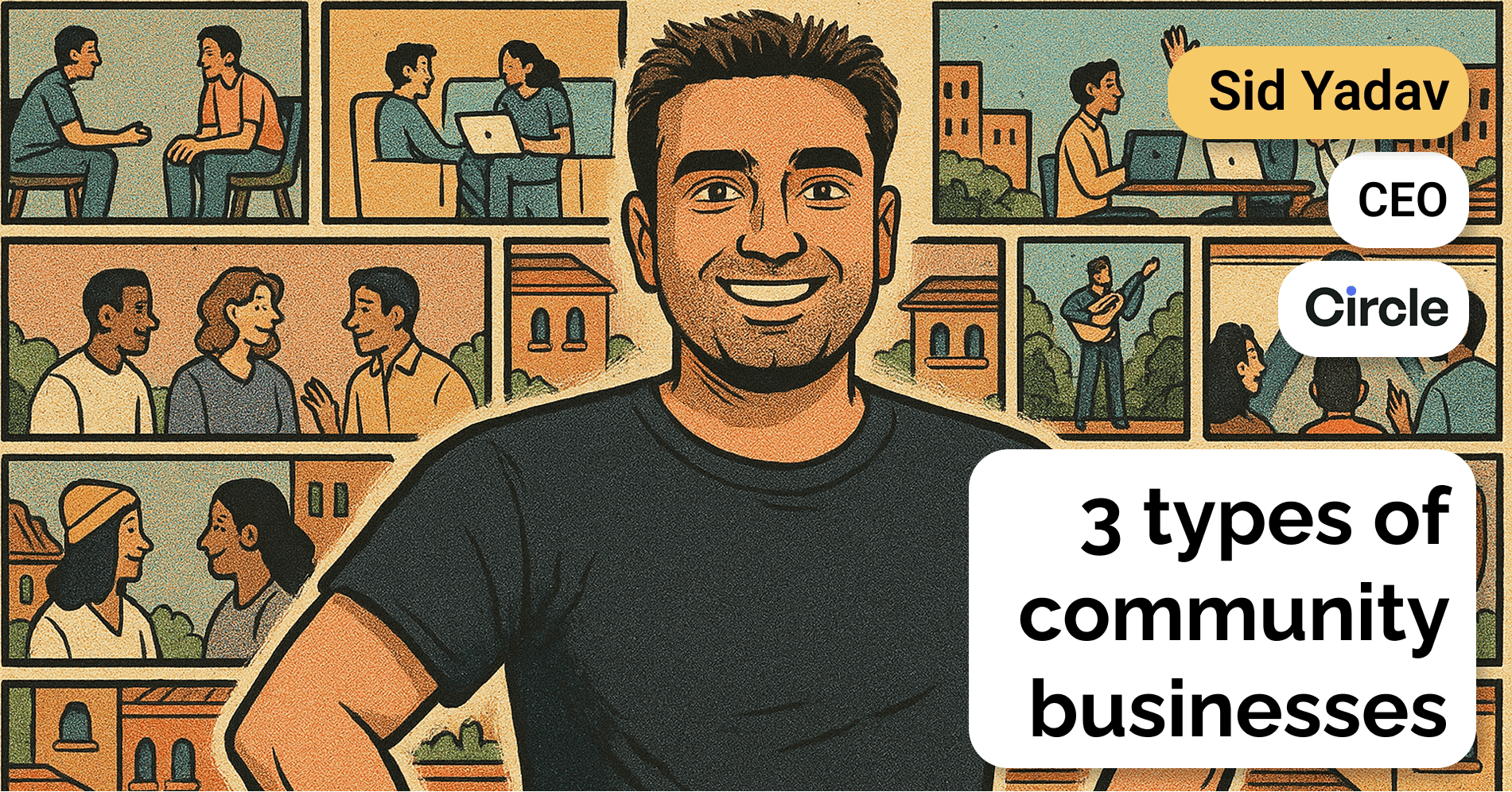Vitalii Dodonov, CTO of Stan, on building a creator-aligned store-in-bio
 Jan-Erik Asplund
Jan-Erik Asplund

Background
Vitalii Dodonov is the CTO of Stan. We talked to Vitalii about Stan's positioning as a mass-market platform for creators compared to niche players like Patreon and Kajabi, the company's decision to charge a monthly subscription fee instead of taking a transaction cut, and how Stan is navigating the dynamics of high churn in the creator economy.
Questions
- Spirituality coaches, passive income gurus, social media coaches, and more use Stan—it feels like an eclectic bunch. How do you talk about and think about Stan's customers and what makes a creator a Stan creator, a Patreon creator vs an online course creator (Kajabi & Thinkific) vs a Passes creator?
- And just to drill in a bit on education, what do you think about Stan’s customer base with respect to online course creators, like people who make courses in Kajabi or Thinkific. Is that a more heavy-duty education use case? Is there sort of a notion of a heavy-duty education-focused creator versus kind of like a lightweight, heavy education-focused creator?
- Which product categories are growing the fastest on Stan, and where do you see the most opportunity?
- The long-held belief is that creators were a hard category to monetize and lacked a willingness to pay. Linktree, for example, is largely free with a $5/mo starter plan. Stan, on the other hand, has no free plan and starts at $29/mo, the same price as Shopify. What do you think about willingness to pay in the creator market, and what has Stan unlocked to drive paid signups?
- Expansion revenue for creator businesses has tended to come from payments (Shopify) or usage (ConvertKit). At Stan, how do you think about expansion, particularly when Stan has sworn off monetizing transactions?
- Churn is 13% monthly. How do you think about churn and net revenue retention at Stan?
- Stan has been growing ~20% month-over-month every month in Q1'24 with high velocity even as revenue continues to scale. Can you talk about word of mouth and Stan's referral program for driving growth?
- In terms of the referral program, it seems like this is pretty widespread, and creator products have a referral program. Is there a reason why you think Stan's program seems much more successful in encouraging the type of behavior that you're talking about?
- How do you think about de-risking the high percentage of GMV that comes from Instagram, given that platform's push into enabling creators to sell on the platform?
- Did you do anything intentional to move from TikTok to Instagram in terms of from a product perspective? You mentioned that most creators were on both TikTok and Instagram. How did the GMV shift so much if that were the case?
- Passes is a fast growing creator platform that calls itself a "Gen Z Patreon". How do you see the positioning with respect to Passes? How do you break down the creator market generally?
- Creator platforms like Beehiiv and ConvertKit have built recommendation networks to network creators with each other and ad networks to network creators with brands. What is Stan's approach to building a network? Or do you think of it as more of a platform like Shopify?
- Data we've seen says ~70% of creators say direct brand deals are their top income source. Yet we've heard from brands that search/discovery and matching with creators is broken, and no one has stepped in to fix this at scale. What tooling do brands need to better connect and transact with creators? Why have platform/marketplace approaches failed or at least not noticeably succeeded?
- If everything goes right for Stan over the next 5 years, what does it become, and how is the world changed?
Interview
Spirituality coaches, passive income gurus, social media coaches, and more use Stan—it feels like an eclectic bunch. How do you talk about and think about Stan's customers and what makes a creator a Stan creator, a Patreon creator vs an online course creator (Kajabi & Thinkific) vs a Passes creator?
We have a lot of conversations about who the ideal customer is for us. The industries you mentioned are certainly big ones for Stan, but they're not the only ones. There are a lot of creators from niches you wouldn't even think about—people teaching you how to groom your dog, how to fish, and seemingly random things like that.
Stan's mission is to help anyone make a living and work for themselves. Our vision stems from there.
The common story we hear is that people either start being interested in side income streams or lose or quit their jobs, but they're like, "Well, I want to do something I'm passionate about," which oftentimes gets them into content creation.
If you have expertise in a particular area and are skilled at it, you would naturally create content around it and build a community or followers around yourself. Eventually, you may start thinking about ways to monetize your skills. This is where Stan can come in. We focus on creators who focus on educating and sharing knowledge through their content.
And just to drill in a bit on education, what do you think about Stan’s customer base with respect to online course creators, like people who make courses in Kajabi or Thinkific. Is that a more heavy-duty education use case? Is there sort of a notion of a heavy-duty education-focused creator versus kind of like a lightweight, heavy education-focused creator?
There is a category of creators who are very sophisticated in terms of what they want to do. They know because they've done a version of it in the past, "If I'm going to create this course, this is how I'm going to sell it, this is how I'm going to market it, it's going to make $200,000 plus."
They are likely to be looking for something very specific. There are creators like that, but then there are other creators who are, "I want to talk about how to lose weight. I'm just passionate about it. I know everything related to it. I know the perfect exercise routine and how to put together the diet. I just want to start sharing."
In this case, you don't want to spend months putting together a sophisticated course to sell for a lot of money. It feels too hard. You want to start with something much, much easier—maybe even free. You want to start converting your followers into customers, collecting their emails, and engaging with them in some way.
Our customers generate more than 50% of their income on Stan by selling digital downloads. These downloads are typically documents where they summarize everything they know about a particular topic that they have been sharing in their content. The prices of these downloads are quite affordable, ranging from $4 to $30.
Essentially, that's a version of a course condensed to something very quick to digest and highlights the most important points. What do you need to know about weight loss? Here are the key factors for you to start paying attention to. It's easy and fast to make. Our creators resonate with that model.
Which product categories are growing the fastest on Stan, and where do you see the most opportunity?
The three biggest ones would be digital downloads, meetings, and courses.
On the feature landscape, Stan is intentionally much simpler than other platforms. It's very easy and quick to set up courses. Over 50% of our GMV comes from digital downloads. They have a really strong product-market fit in our space.
Meetings are effective because the simplest product you can sell on the internet is time with yourself. Even if you have no product, you can have a conversation with the other person.
Again, just sticking with the health analogy, if I think highly of you, you've developed credibility with me because of your content, and you know how to eat healthy and exercise, I would be up for picking up to scheduling a consultation with you.
And if you charge me for it, that would be okay with me just to have the time with you that I wouldn't have an opportunity to do otherwise. So meetings, courses, and digital downloads would be the biggest products.
The long-held belief is that creators were a hard category to monetize and lacked a willingness to pay. Linktree, for example, is largely free with a $5/mo starter plan. Stan, on the other hand, has no free plan and starts at $29/mo, the same price as Shopify. What do you think about willingness to pay in the creator market, and what has Stan unlocked to drive paid signups?
Again, I think the difference comes down to the target customer. When we are positioning ourselves in a landscape of Linktree versus Shopify, Linktree, on one end, is positioned for influencers and lifestyle creators who want to organize their links and affiliations in one place. It's very lightweight.
Shopify, on the other hand, is much more difficult to set up. It'll take a couple of days to get it right, but if you want to sell physical products on the internet, you do it with Shopify.
For us, the problem that we solve and, essentially, the creators' needs we serve are much closer to Shopify than they are to Linktree. The decision behind our pricing is also very much intentional, as we see ourselves as a premium product. Stan replaces multiple platforms that would cost $100s for just $29, connecting the dots all in one place.
We are very comfortable with creators trying and exploring other alternatives before they come to Stan.
But because we are working with people who have high intent, who are serious about using this product to monetize rather than just serve as a website—and if they truly succeed and make money on the platform—the price we're charging them is very affordable.
Also, in competitive analysis, if you see what Stan offers and what kind of tools it replaces for just $29 per month total, even if you make a million dollars on the platform, we're still going to charge you $29 per month. It's truly the best offer out there.
Expansion revenue for creator businesses has tended to come from payments (Shopify) or usage (ConvertKit). At Stan, how do you think about expansion, particularly when Stan has sworn off monetizing transactions?
We decided not to monetize payments two years ago because, when we were looking at conversations around the topic at the time, we learned that the transaction cut is a sensitive subject for people.
In their mind, it's like, "Are you the middleman who takes a cut from us, or are we on the same side?"
We have consistently prioritized a creator-first mentality. These decisions have helped us achieve the remarkable growth we have seen so far.
When we think about expansion, there are generally two ways:
You can expand vertically by upselling to the same customers or by acquiring a larger market share. We've positioned our product and our mission to help as many people as we can to make a living working for themselves.
In order to grow further, our plan is to offer exceptional service to our existing customers, making them feel satisfied, grateful, and enthusiastic about using our product. By doing so, they will spread the word about our platform to their followers, create content based on their experiences, and inspire others to join our community. This formula has proven successful for us thus far.
Churn is 13% monthly. How do you think about churn and net revenue retention at Stan?
Churn is definitely important. It would be tough to say, "Hey, we have 13% churn, and it's a great thing." It's not.
13% churn means that we are going to turn over our entire user base over the year. That's a scary place to be, and at the same time, when you also speak to SaaS-minded people, there's a strong emphasis that this is something that we need to deal with.
We've done a number of things that we thought would be helpful. All of which were unsuccessful. That led us to ask fundamental questions, such as, "Well, what is the underlying dynamic there?"
While I don't have the answer to what it actually is, I do have a hypothesis. I read a report that estimated the size of the creator economy at 100 to 200 million creators. Only a fraction of them are interested in monetizing. We also learned that there is a life cycle to being a creator.
For example, if you decide to become a traditional entrepreneur, people often stick with it for a long time. But if you are a creator, there is a small fraction of people who come and stay versus those who come, try things out, explore, maybe entertain the idea for a year or two, and then move on to do something different.
One of the marketplace dynamics at play is that the entire creator economy churns, let's just arbitrarily say once every three years. The entire ecosystem is going to get new players, with a small fraction of folks staying around.
Now there's kind of coming and going, and if this is a dynamic that we are working with, then you can make an argument that the 13% churn isn't that bad because people are churning not because of the product, which is what we are in control over. People churn because life happens and they have changing priorities.
Our number one priority is to ensure we have the very best product out there for our target demographic.
Number two is currently focusing on building a strong brand image. This largely ties back to our creator-first mentality. We hope to attract the next generation of creators to our platform, thus expanding our user base and growing our business.
Stan has been growing ~20% month-over-month every month in Q1'24 with high velocity even as revenue continues to scale. Can you talk about word of mouth and Stan's referral program for driving growth?
I wish I could tell you something really sophisticated about this, but it's very simple for us. We have a good product and a single distribution channel, which is word of mouth. We don't put any money into marketing. You would probably see a few ads on Google that we probably spend $500 total just to rank for the "Stan store" keyword. Everything else is very organic.
As a creator, you would say something along the lines of "Buy my course from my Stan store." You also have a Stan URL in your link-in-bio, so our brand is visible to all your customers. And then you might mention Stan in your content as well. This introduces brand awareness in the creator economy as creators regularly follow other creators to see which services and tools are working for others.
We have to be careful when working with creators. They're very public—if you do something good for them, they'll share it. If you mess something up, they'll also share it. So, you must be very careful only to give positive experiences to people. We’ve created our referral program to encourage these behaviors.
In terms of the referral program, it seems like this is pretty widespread, and creator products have a referral program. Is there a reason why you think Stan's program seems much more successful in encouraging the type of behavior that you're talking about?
It's not just about the referral program. The referral program is there, but it wouldn't work in isolation. It works in combination with the product itself.
When you visit a restaurant, they may ask you to leave a review. Sometimes, they may even offer you a free coffee or dessert in exchange for it. However, there are some places where you would not leave a review no matter what. This is either because the experience was extremely bad, and you don't want to come back again, or it was just unremarkable, and you don’t want to associate your name with it, no matter the incentive. On the other hand, if the experience was exceptionally good, you may go out of your way to leave a positive review on Google so that others can learn about it, too. The restaurant has to be great in order for you to promote it. There are ways to gamify it, but it’s likely short-lived. There has to be substance and a great substance for the word to spread at scale.
How do you think about de-risking the high percentage of GMV that comes from Instagram, given that platform's push into enabling creators to sell on the platform?
We originally started to build the Stan brand on TikTok, so there was a time when 90% of our customers were TikTok creators. Later on, we figured out that creators have a higher likelihood of being able to monetize—not succeed—but specifically monetize on Instagram. Now, the majority of our customers are active on both platforms.
Zooming out from there, if TikTok gets banned, it's going to be an unfortunate cultural event. But will there be fewer creators in the world? Probably not.
What are the two possible outcomes of it in terms of the business landscape?
Either everyone is going to migrate to Instagram or to other platforms, and essentially they would still continue to have the need to monetize, which means not much would change for Stan from that perspective. Or another platform will come around that will replace TikTok, and we will see the same dynamic.
We've built Stan very intentionally to be independent of our distribution channels. We can operate on any platform because we are focusing on the creator.
Even if the distribution channels come and go, the fundamental problem that Stan exists to solve, helping people to monetize their content, is going to stay. We are staying laser-focused on the customer.
Did you do anything intentional to move from TikTok to Instagram in terms of from a product perspective? You mentioned that most creators were on both TikTok and Instagram. How did the GMV shift so much if that were the case?
A lot of the distribution is brand-driven. You get more customers when you show up more in their daily routines. We started by creating content only for TikTok, so that’s where our customer base started to grow.
Then, we shifted to Instagram. The word spread, and more and more creators on Instagram started paying attention.
Passes is a fast growing creator platform that calls itself a "Gen Z Patreon". How do you see the positioning with respect to Passes? How do you break down the creator market generally?
We do not actually hear a lot about Passes in our space, and that's because we are just serving a very different target demographic. They are focusing on folks who are in the 100,000+ followers area, which is a very special part of the creator economy.
Stan's positioning is that we are here to help anyone to be able to make a living for themselves. From that perspective, we are a mass-market service. We are not trying to build an exclusive community but to create an equal opportunity for all creators.
If you're trying to build a community and you are in that 100,000+ followers range, then perhaps Passes is a potential option for you. But if you have 10,000 followers and you are on the journey of sharing your knowledge through content and monetizing it, then Stan is there for you just as well as it’s there for creators with larger audiences.
We are not going into their space, and they don't come into ours because we serve different people.
Creator platforms like Beehiiv and ConvertKit have built recommendation networks to network creators with each other and ad networks to network creators with brands. What is Stan's approach to building a network? Or do you think of it as more of a platform like Shopify?
We certainly noticed many players in the market trying to build something like this, and we explored it to some degree.
But the question really comes down to whether you have a product-market fit there and whether this is truly what your customers need. We could build many features, but you have to ask yourself, what's the point?
With a network-type product, we just didn't see a compelling argument for us right now.
Let's think about the role that Stan has in the creator's mind. You have a newsletter where you can recommend other creators to your followers. Is it a good thing for you to distract your audience by telling them about other relevant creators they could engage with or purchase from instead of focusing on your products?
We're not a social media platform where we're trying to connect people and help them build their following. That's not our business. Our business is to maximize the creator's income, so we’re laser-focused on that.
Data we've seen says ~70% of creators say direct brand deals are their top income source. Yet we've heard from brands that search/discovery and matching with creators is broken, and no one has stepped in to fix this at scale. What tooling do brands need to better connect and transact with creators? Why have platform/marketplace approaches failed or at least not noticeably succeeded?
I think there's a decent chance everything can be bridged at some point. It really comes down to: Is this a priority, and is that something that you want to do?
If you look at the fundamental dynamics of why a brand would reach out to you, it's because you have the audience size that they believe they would be able to sell their product to, and then you would get a cut of what was sold to for yourself.
We argue that if this is the kind of audience you have, wouldn’t you be better off selling your product?
If everything goes right for Stan over the next 5 years, what does it become, and how is the world changed?
I think we would achieve our mission if, in five years, Stan became synonymous with the creator economy.
That's true when people think, "Well, I want to do something of my own and start creating content," and their first thought is setting up their Stan store.
Disclaimers
This transcript is for information purposes only and does not constitute advice of any type or trade recommendation and should not form the basis of any investment decision. Sacra accepts no liability for the transcript or for any errors, omissions or inaccuracies in respect of it. The views of the experts expressed in the transcript are those of the experts and they are not endorsed by, nor do they represent the opinion of Sacra. Sacra reserves all copyright, intellectual property rights in the transcript. Any modification, copying, displaying, distributing, transmitting, publishing, licensing, creating derivative works from, or selling any transcript is strictly prohibited.






